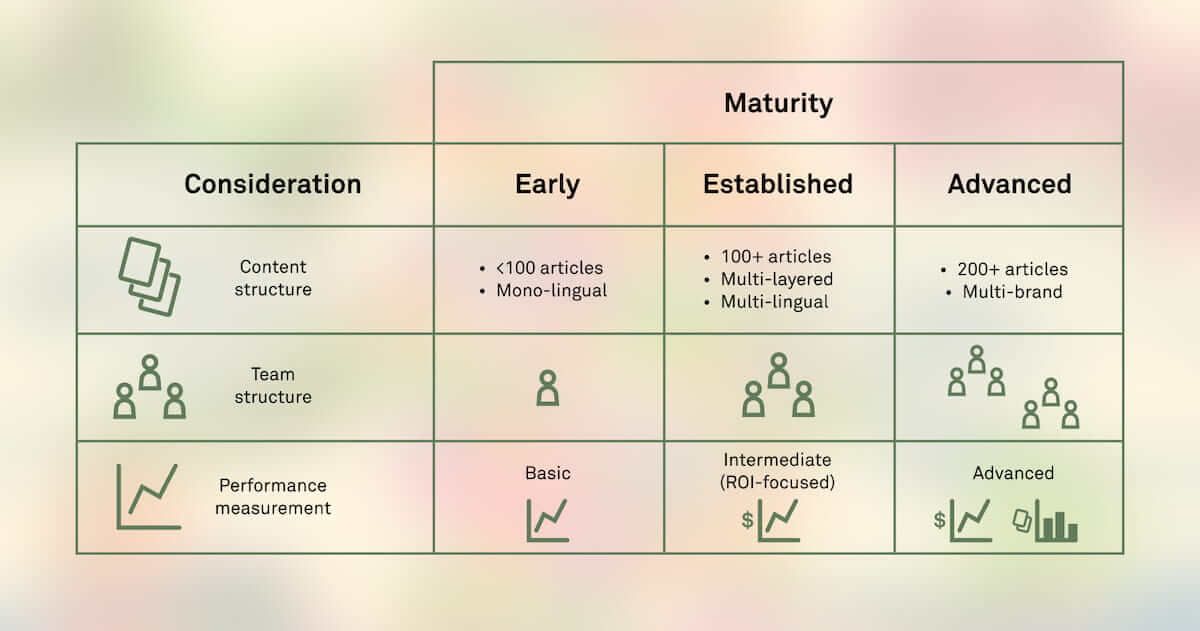
Moving upmarket as a product manager: What changes and what stays the same?
Main illustration: Jovaney Hollingsworth
As Intercom grows, we’re moving into new markets and serving new customers. For product managers, this means evolving to build for upmarket companies while ensuring Intercom’s long-standing customers remain at the center of what we do.
Product management varies depending on your industry, company stage, company leadership, or teammates. But one thing is consistent across every product management role – a deep focus on the customer.
In recent years we have increasingly focused on upmarket, enterprise-scale customers. This is a natural evolution for many SaaS tools as they move towards a healthier economic model, as captured in Christoph Janz’s seminal 2014 blog.
The challenge for product managers is ensuring that your product evolves to meet the needs of your new customers without leaving long-term, smaller customers behind. Here are three beliefs we’ve followed at Intercom as we’ve begun to broaden the range of companies we work with.
1. Customer behavior is more important than company size
At Intercom, we obsess about our customers’ success. We solve customer problems by deeply understanding the jobs that they use our product to tackle, often applying the jobs to be done framework.
When we view bigger customers through this lens, we don’t focus on their employee count, revenue, or market capitalization. What really matters is understanding customer behaviors. We spend time studying the challenges they face each day, the opportunities our product can unlock for them, and how they might use Intercom to solve problems.
“Instead of considering company size when prioritizing the problems to be solved, we classified based on maturity of a customer’s knowledge base”
This approach was crucial to designing our Articles product. There are lots of features that content authors and support managers need to see in their knowledge base product – and as companies grow in size, that list of required features grows too. Instead of considering company size when prioritizing the problems to be solved, we classified based on maturity of a customer’s knowledge base using three labels: early, established, or advanced.

Classifying customer knowledge base maturity when building Intercom’s Articles product
Early customers have smaller content libraries (less than 100 articles), fewer authors, and uni-layered, mono-lingual content structures. Established customers have more content (100+ articles), between three and five content authors, and more complex content structures. Content performance and return on investment is likely to be measured more closely.
Advanced customers have large volumes of content (200+ articles), five or more authors with dedicated writing teams and managers, and a multi-layered content hierarchy. They might also have a team dedicated to measuring and optimizing their content’s performance.
These labels allowed us to better understand which problems our customers needed us to tackle, and in what sequence.
2. Building for bigger customers doesn’t mean building only for your biggest customers
It’s easy to fall into the trap of thinking that building for upmarket customers means building only for your biggest customers, and ignoring the rest. Your biggest customers are likely in frequent contact with your sales teams, and there’s a risk that their feedback will carry more weight as an input into your product decisions.
It’s important that product decisions don’t neglect your wider customer base – ignoring the needs of a subset of customers is not only a churn risk, it stunts your product’s growth. You always want to build for your desired future customer, whose characteristics align with your product strategy.
“We’ve built mechanisms to help us seek inputs from customers we don’t hear from using interviews, surveys, and data analyses”
So, how do we do that at Intercom? Well, it’s hard. But over the years, we’ve put processes in place to make it easier. First, we are careful to appropriately weight all customer feedback (or inputs) by centralizing them within a single tool. Secondly, we’ve built mechanisms to help us seek inputs from customers we don’t hear from using interviews, surveys, and data analyses.
Finally, as we’ve moved upmarket, we’ve worked hard to ensure our sales and product teams collaborate deeply and effectively.
3. Build for your customers, not your competitors’ customers
During a conversation on the Intercom on Product podcast, Des Traynor and Paul Adams discussed the competition between startups and incumbents. In the race for market share, startups try to close the gaps on incumbent companies, while incumbents try to build new, differentiator features. Whoever does it fastest will win.
“Understand whether your customers want these features because they’re essential to their operations, or because your competitors have them”
As your sales team deals with more upmarket prospects, it’s inevitable that prospective customers will request “industry-standard” features within your product. It’s important to understand whether your customers want these features because they’re essential to their operations, or because your competitors have them. Do they actually use these features? Do these features solve a problem for them?
“Industry-standard” isn’t always a priority
There are baseline expectations for features of a modern-day SaaS tool. Features that satisfy legal necessities, like GDPR compliance for EU customers; or effective employee management, like granular permissions for accounts.
But there are some features which you should think twice about prioritizing – those that don’t add as much value as you might think. It might be the case that only a handful of customers are really using dark mode, and what they really want is neon mode.
An example where we’ve committed to an industry-required feature is our recent HIPAA attestation, a critical standard for protecting people’s health data. As we moved upmarket, we saw strong demand from healthcare-related companies and recognized the urgency of this investment.
“Customers were keen to send transactional messages with Intercom, but instead of implementing the industry-standard solution, we looked a little closer at the needs of our customers and their users”
We took a different approach to our recently launched multichannel transactional messaging feature. Customers were keen to send transactional messages with Intercom, but instead of implementing the industry-standard solution, we looked a little closer at the needs of our customers and their users. Leveraging the unique channels which make us Intercom, we built a transactional messaging feature that allows customers to connect with their users wherever they are through timely, relevant, personalized messages.
We’re excited to keep growing, serving new customers while continuing to obsess about every customer’s success. Sound like something you’d be interested in? We’re hiring product managers – check out our open roles.








